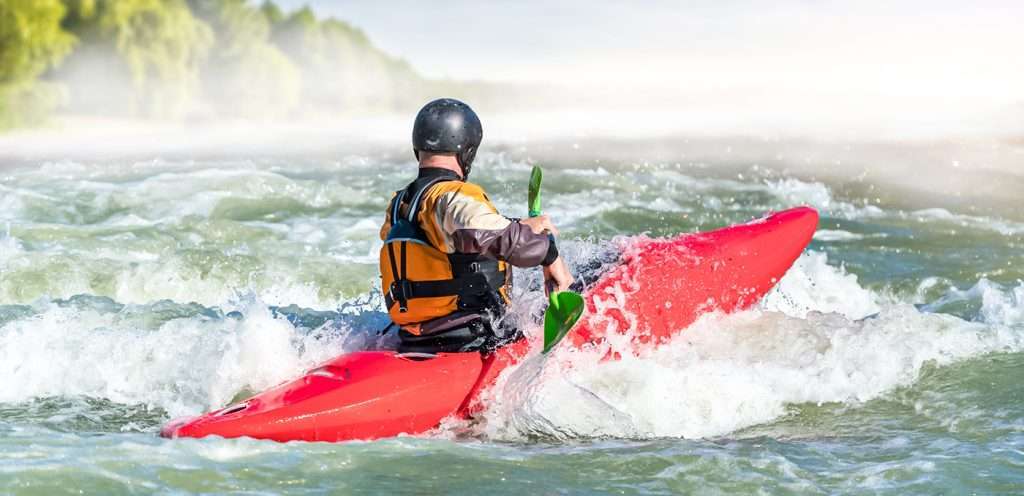Negotiating whitewater rivers requires good Kayaking Skills, river knowledge, and of course, Kayaking protocols. The following articles will provide you with the fundamentals of Whitewater Paddling which will surely make a difference when you are already running whitewater rivers.
Eddy Use & Etiquette
Eddies are places where paddlers can stop for a while or relax before they start Paddling again. Paddlers can rest, eat, or mingle around with other paddlers in eddies, which generally vary in size. Eddies range from very small ones, which are hardly noticeable to beginners to the very large ones, where a whole group can stop and stay.
Since being in eddies is usually a social experience, it is imperative that paddlers should observe certain protocols. Eddies are used as resting spots, and paddlers look forward for a few minutes of relaxation in between periods of dealing with roaring rapids. Here are some of the guidelines with regards to Eddy Use and Etiquette:
- The paddler who comes first into an eddy should move away from the eddy line so that the next paddler can enter conveniently at the top. This means that whoever comes first has to be the last one who leaves the eddy.
- If paddlers are lining up on top of the eddy, all wanting to leave the eddy first, one should join the queue like everyone else. If you really want to be at the top of the eddy, wait for the more experienced paddlers to allow you.
- Ensure that no one’s paddling downstream, who will move closer to you, whenever you are going to leave an eddy.
- When paddling in a group, every one should know that he or she can catch one another whenever the group goes eddy-hopping or when going from one eddy to the next.
- Before leaving, paddlers should have already considered their next stop. Every paddler, therefore, should know where to eddy out next.
When using eddies, paddlers should be, first and foremost, considerate with other paddlers. Eddies are good places for resting and for parking. Spare everyone from experiencing inconveniences by simply observing Eddy Etiquette.
Running Rapids
Hydraulic features found in whitewater rapids are undeniably potential hazards. Kayakers would face turbulent waves and powerful holes, which are the most common, unavoidable hydraulic features. Therefore, it is logical and essential to know how to avoid and / or deal with them in a Kayaking trip.
Here are some of the guidelines kayakers should consider when tackling rapids:
- Play around small holes to practice your moves, and then gradually move on to the difficult ones. Watch how other kayakers tackle hydraulics, and visualize how you will do it by yourself.
- You can paddle over unbroken waves, which are usually not a problem among kayakers. It is the big unbroken waves positioned close together that may hold or hurl kayakers. Take a diagonal route to get over these waves.
- When in a very powerful hole with aerated water, move downstream to avoid being sucked in. Holes are capable of stopping and holding a boat, including the kayaker.
- If there’s a lot of water moving sharply into a hole, move to the bank, which is the most practical route or to move on either side of the hole. Paddlers who get caught in a powerful hole may not be able to escape.
- When you are in a powerful stopper with an elevated pile, paddle out of the end of the pile to escape from it. Though capable of holding a boat indefinitely, a kayaker can still be in control. You can be flushed downstream if you decide to swim.
- Learn how to spot passages downstream so that you can escape easily if you get stuck in hydraulics.
Take note that hydraulic features can become hazards. Consider the above guidelines before you go on an extreme Whitewater Kayaking trip. Following these guidelines would help you successfully finish a Kayaking trip, and of course, to avoid getting stuck in a hydraulic for an indefinite time.
Running Drops
Any kind of drop, whether it’s sloping or vertical, may pose danger to kayakers. Therefore, it should be handled with careful planning and procedure.
Moving through a sloping drop entails paddling through a big hydraulic at the bottom. The best spots for paddling through are downstream Vs, as well as gaps in the pile. When going down a water ramp with two or more flows crossing each other, you should position yourself on the top flow.
When you plan to go down a vertical drop such as waterfalls which usually have powerful hydraulic re-circulation systems at the bottom, consider the height of the drop. Since going down a vertical drop is a serious matter, mull over your plan carefully. Ask yourself: Can you go down the drop uninjured?
Basically, there are two ways of running vertical drops: meltdown and boof.
Meltdown involves going through or under the hydraulic. On the way down, you have to make sure that your hull stays in contact with the water. With your weight forward while on the lip of the drop, move down with your Kayak Paddle placed along the boat. Control your speed if the drop is steep.
Boof, on the other hand, entails projecting the boat forward, and making it land flatly on its hull. This involves serious Paddling before leaving the lip, and making a last stroke before take-off. Boofing is not recommended when running a very high vertical drop except if the water below is very aerated.
Mainly, you need to know what the water below is like when running any kind of drops. You can measure the depth through the use of a paddle. Make sure that there are no obstructions like rocks or trapped trees under the water. Obstacles on the water may entrap you and your Kayak once you go over the drop.

